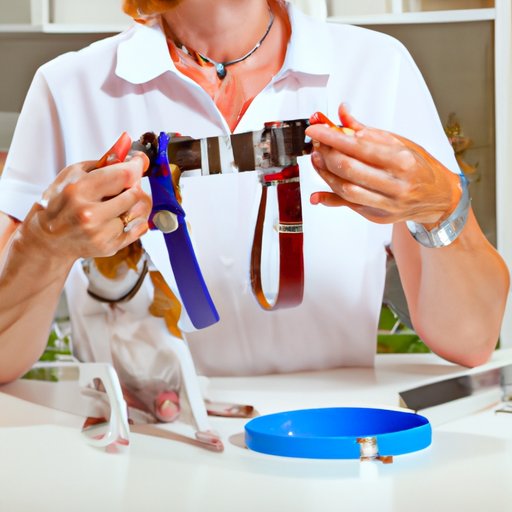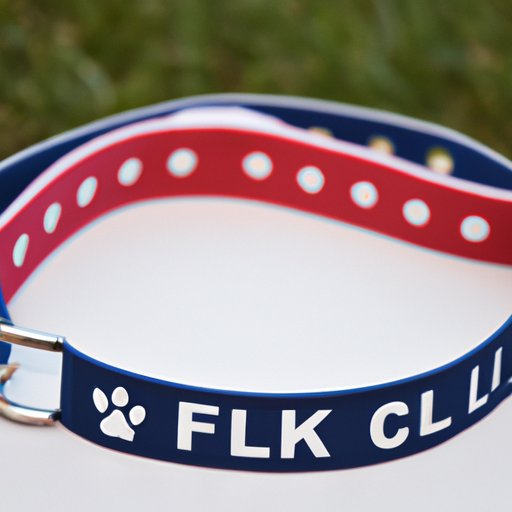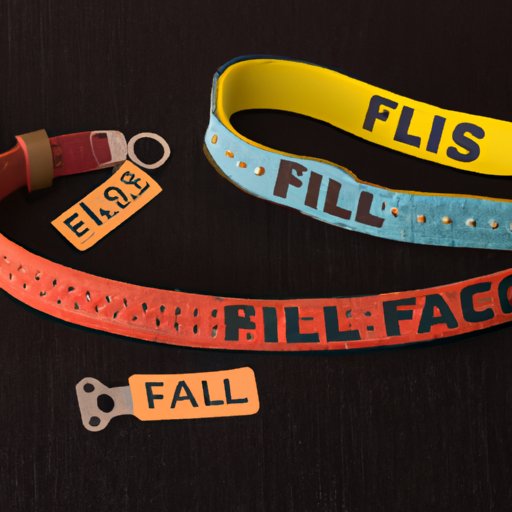Introduction
Flea collars are an important part of pet care, as they provide protection against fleas and other parasites. But how do flea collars actually work? This article will explore the science behind flea collars, discuss the different types available, and provide a step-by-step guide to applying one on your pet. We’ll also look at the benefits of using a flea collar and address some common misconceptions.
The Components of a Flea Collar and What They Do
Flea collars contain several key components that make them effective in killing and repelling fleas. The main components are active ingredients, adjuvants, and repellent properties.
Active Ingredients
One of the most important components of a flea collar is the active ingredient, which is what kills the fleas. Common active ingredients used in flea collars include pyrethrins (synthetic derivatives of chrysanthemum flowers), organophosphates, and carbamates. These active ingredients act as insecticides, which means they kill insects by disrupting their nervous system. Pyrethrins are generally considered the safest option, as they break down quickly in the environment and are less toxic to mammals.
Adjuvants
Adjuvants are substances added to the active ingredient to improve its effectiveness. They can help the active ingredient spread more evenly across the surface of the collar and increase its ability to kill fleas. Common adjuvants used in flea collars include surfactants, emulsifiers, and solvents.
Repellent Properties
In addition to killing fleas, many flea collars also contain ingredients that repel fleas and other parasites. These ingredients create an invisible barrier around your pet that fleas can’t penetrate. Common repellent ingredients include essential oils like citronella, lavender, and peppermint. A study conducted by the University of Florida found that flea collars with these essential oils were effective in reducing flea populations in dogs and cats.

Examining the Different Types of Flea Collars
There are three main types of flea collars available: blocker, medicated, and natural.
Blocker Flea Collars
Blocker flea collars contain active ingredients that kill adult fleas and prevent new fleas from infesting your pet. These collars typically contain synthetic insecticides such as pyrethrins or organophosphates. Blocker collars are most effective when used in conjunction with other flea control methods, such as regular vacuuming and treating your pet’s bedding.
Medicated Flea Collars
Medicated flea collars are designed to kill adult fleas, larvae, and eggs. These collars contain higher concentrations of active ingredients than blocker collars, so they offer more comprehensive protection against fleas. However, they may be more toxic to humans and pets, so it’s important to use them according to the manufacturer’s instructions.
Natural Flea Collars
Natural flea collars contain plant-based ingredients that act as both insecticides and repellents. These collars typically contain essential oils, such as citronella, lavender, and peppermint. While natural flea collars are generally safer for people and pets, they may not be as effective as other types of collars in killing fleas and preventing re-infestation.
A Step-by-Step Guide to Applying a Flea Collar
Applying a flea collar correctly is essential for ensuring your pet’s safety and comfort. Here’s a step-by-step guide to applying a flea collar on your pet:
Cleaning Your Pet’s Fur
Before you apply the flea collar, it’s important to clean your pet’s fur. Start by brushing your pet’s fur to remove any matted fur, then use a mild shampoo to wash away any dirt and debris. Rinse your pet thoroughly, then towel dry and brush again.
Choosing the Right Size of Collar
When selecting a flea collar, be sure to choose one that is the right size for your pet. The collar should fit snugly around your pet’s neck, but not too tight. To measure the correct size, wrap a measuring tape around your pet’s neck and add 2 inches to the measurement.
Placing the Collar on Your Pet
Once you have the correct size of collar, place it around your pet’s neck. Make sure the collar isn’t too tight or too loose. It should be snug enough that it won’t slip off easily.
Adjusting the Tightness
Finally, adjust the tightness of the collar to ensure your pet’s comfort. You should be able to fit two fingers between the collar and your pet’s neck. If the collar is too tight, loosen it until it fits properly.
Exploring the Benefits of Using a Flea Collar
Using a flea collar has many benefits for your pet. Here are some of the most notable ones:
Kills Existing Fleas and Prevents Re-infestation
Flea collars are effective in killing existing fleas and preventing re-infestation. Most flea collars contain active ingredients that kill adult fleas, larvae, and eggs, so they can provide long-term protection against fleas.
Cost Efficiency
Flea collars are relatively inexpensive compared to other flea control methods, such as topical treatments and oral medications. Additionally, flea collars last for several months, so you don’t have to worry about reapplying them frequently.
Easy Application and Maintenance
Applying and maintaining a flea collar is easy. All you need to do is put the collar on your pet and check it periodically to make sure it’s still snug. That’s it!

Addressing Common Misconceptions About Flea Collars
Despite the benefits of using a flea collar, there are still many misconceptions surrounding them. Let’s take a look at some of the most common myths:
Myth: Flea Collars are Toxic
Many people believe that flea collars are toxic to humans and pets, but this isn’t necessarily true. While some flea collars contain synthetic insecticides that can be toxic, many natural flea collars contain plant-based ingredients that are safe for people and pets. Be sure to read the label carefully before purchasing a flea collar to make sure it doesn’t contain any potentially harmful ingredients.
Myth: Flea Collars Can’t Kill Eggs
Another common misconception is that flea collars can’t kill flea eggs. While it’s true that some flea collars may not be effective in killing eggs, many do. Medicated flea collars contain higher concentrations of active ingredients that can kill eggs, as well as adult fleas and larvae.
Myth: Flea Collars Don’t Last Long
Finally, some people believe that flea collars don’t last very long. However, most flea collars are designed to last for several months, so you don’t have to worry about reapplying them frequently. Just be sure to check the collar periodically to make sure it’s still snug.

Tips for Choosing the Right Flea Collar for Your Pet
Now that you know more about how flea collars work, let’s look at some tips for choosing the right one for your pet:
Consider Your Pet’s Weight and Size
When selecting a flea collar, be sure to consider your pet’s weight and size. Choose a collar that is the right size for your pet – too big and it won’t be effective, too small and it could be uncomfortable.
Choose a Collar That is Waterproof
It’s also important to choose a collar that is waterproof. This will ensure that the active ingredients remain effective even if your pet gets wet.
Choose a Collar That is Scented or Unscented
Some flea collars contain fragrances that can irritate your pet’s skin. If you’re concerned about this, look for a flea collar that is either scented or unscented.
Read Reviews Before Purchasing
Finally, make sure to read reviews before purchasing a flea collar. This will give you a better understanding of the collar’s effectiveness and any potential side effects.
Conclusion
Flea collars are an important tool in pet care, as they provide protection against fleas and other parasites. This article has explored the science behind flea collars, discussed the different types available, and provided a step-by-step guide to applying one on your pet. It has also looked at the benefits of using a flea collar and addressed some common misconceptions. Finally, it has offered some tips for choosing the right flea collar for your pet.
(Note: Is this article not meeting your expectations? Do you have knowledge or insights to share? Unlock new opportunities and expand your reach by joining our authors team. Click Registration to join us and share your expertise with our readers.)
